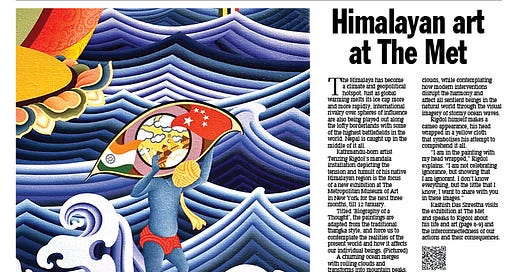Dear Nepali Times Readers,
Central Nepal this weekend suffered a devastating flood that left at least 180 people dead. Those of you in Kathmandu may have experienced the incessant three-day downpour, and those abroad will have seen the horrifying images and videos.
Kathmandu Valley, especially its southern fringes, saw half the average annual precipitation in two days. In some parts, continuous rain dumped 600mm in 24 hours — the heaviest rain since records started being kept.
Even at the best of times, Kathmandu Valley would not have been able to cope with such freakish rain. But floodplains have been encroached, illegal sand-mining and quarrying increased the sediment load and velocity of the flood waters. As is usually the case, the most deprived communities who lived in the most risky areas suffered the most.
Livestock has been lost, standing crops ruined, and thousands of homes have been destroyed. More than two dozen hydropower plants generating 1,700 megawatts have been knocked out, and Nepal has lost half its electricity capacity (hopefully temporarily). Nepal’s highways have been ravaged just ahead of the Dasain season when people go home to the districts.
The prime minister cut short his visit to the United States, and returned on Sunday. The government has been slow to respond, but what else is new?
The disaster in Nepal this week is a warning about climate-related disasters to come. And on page 13, we bring you a heart-warming story of the Nepali folk-classical band Sukarma which played a series of fund-raising concerts in Switzerland to raise money for devastating floods in the Ticino area in June. Sukarma had performed in Switzerland to raise money for the 2015 earthquake relief in Nepal, and this is first time Nepalis have reciprocated in this way.
In the midst of all this, Nepali Times this Friday brought a review of Tenzing Rigdol’s exhibition ‘Biography of a Thought’ at The Met in New York. Kashish Das Shrestha reviews the exhibition (page 1 and 8-9) and talks to Kathmandu-born Rigdol about his mandala installation that forces us to contemplate the turmoil and tensions of a planet beset by wars and climate breakdown. Go online to watch video. If you are in the area, please visit — the show is on till 12 January.
Elsewhere, in edition #1231 Chandrakishore reports from the Tarai about the snakebite emergency. An average of 10 people are killed every year in Nepal by wild tigers, but 3,000 are killed annually by snake bites. But guess which gets more media attention.
Reporter Dhanu Bishwakarma reports (‘Banning Banishment Is Not Enough’) from Achham about how many villages in Sudurpaschim Province have rebuilt menstrual sheds that had been demolished in 2019 by the government. Patriarchy and gender exclusion run deep in some parts of Nepal, and laws alone are not enough to change behaviour.
And on Monday, the rain-delayed finals of the BYD Himalmedia Valley Slam tennis tournament will held at the Satdobato grounds. Abhilasha Bista and Sunira Thapa will play for the women’s finals while Pradip Khadha and Pranav Manandhar will compete for the men’s singles. Congratulations to them, and all 120 participants.
Yours truly also partnered with Ram Bahadur Lama in the semifinals (pictured) but lost 6-0. 6-1, so I am off to practice.
See you soon.
Kunda Dixit









Kunda Dixit, next time i'm in Nepal, I'll give you special tennis lessons . . .